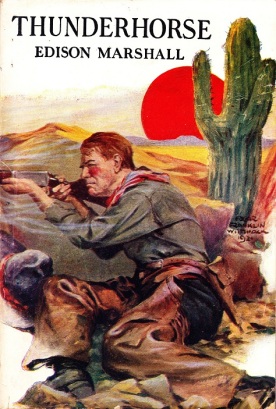
Book 24 wraps up the initial series of western, sea, wilderness and Frozen North tales brought to one and all back in 1923, by the Garden City Publications outfit.
Herewith, we have W. C. Tuttle’s “The Law of the Range.” The original copyright notices states 1922, via The Ridgway Company. This leads me to assume that this tale was originally printed as “The Spark of Skeeter Bill,” in Adventure (30 March 1922).
The tale opens with [cough cough] one Skeeter Bill riding into an ambush. His horse is shot out from under him and dies. Skeeter lays for the assailant, whom courteously makes himself present and open to Skeeter slicing lead through his legs. Tossing his rifle aside, Skeeter, rather than slay the man that slew his horse, demands to know why his was shot at.
The man is a sheepherder, out on the range with his wife. They moved to the range for his health, but the only work he could find was to herd sheep. Well, they are in cow country, and sheepherders ain’t welcomed too warmly. The herder has been harassed by others and assumed Skeeter was riding in to do the same.
Making as pards, the man brings Skeeter home and they have a wonderful sit-down. Now, Skeeter is a wee bit of a flippantly facetious cuss, and as a reader, you sort of chuckle along with his silliness, throughout. Skeeter takes up the task of riding into town for the couple to fulfill their shopping list, since he knows the town won’t allow the couple do buy anything.
Dressed more like a cowman and a gunner himself, Skeeter rides in on the old buckboard, and instantly finds himself the center of attention. Disregarding them, he saunters into the shop and is informed by the keeper they ain’t got nothing on his list. Skeeter makes mental note of what is present and walks the town.
Presently, the sheriff rides in, bleeding from a bullet wound. While the whole town is distracted, Skeeter ambles back into the store and wallops the man with a bag of flour, then, fulfilling the shopping list, leaves the correct amount of funds and departs, returning to the sheepherder’s ranch.
Upon arrival, he notices their shotgun discharged and abandoned on the porch. He doesn’t see the couple, but, finds a man shot down and dead. Heaving the body, he tries to hide the corpse but the sheriff and some others ride over from town, after the shopkeeper makes complaints.
Caught with the corpse, he is arrested and brought in. Refusing to admit his innocence, the judge slaps him with time in the penitentiary. This doesn’t go over well with the cattlemen, since the corpse was the boss of the Tin-Cup ranch! They are all for a lynching party.
The sheriff sneaks him out of the jail cell, days later, at night, during a dark rainstorm. They board a train and make their getaway. Unfortunately, another cattle group are planning to rob the train! To worsen matters, they run across another group with similar plans to stop the train…the Tin-Cup riders are set to stop the train, and lynch Skeeter!
Not knowing whom either group is up against, they shoot it out and one of the party purposely detonates a “torpedo” on the tracks signaling an emergency stop. Just in time, too, since one of the Tin-Cup apparently blew up the train trestle. The train comes to a screeching halt with the engine nearly dangling neatly over the precipice.
The Tin-Cup gang boards and the sheriff coolly wounds two attackers but suffers wounds of his own. Skeeter drags the sheriff along and jumps, making his getaway. Only, that jump never ends. He didn’t know that the train had stopped over the river!
They splash and Skeeter swims to the banks, dragging the unconscious sheriff with him. Out of the water, he finds the keys to the cuffs and makes to vamoose but then, because he IS A GOOD GUY, he goes back to save the sheriff.
Along the way, he picks up some others (I’d be entirely ruining the plot if I explained this part further, which only adds to the hilarious nature of Skeeter and his situation) and they all tromp to the sheepherder’s cabin, only to find yet another wounded person present that is NOT the couple. Skeeter nabs the buckboard and brings in three wounded people.
Meanwhile, in town, all believe he and the sheriff are dead, and the doctor is tending the two Tin-Cup gang that the sheriff shot on the train. They live. In walks Skeeter with all three…the sheriff, a hired gun man, and the fellow from the ranch (whom was there to kill the husband and take the purty wife, but I won’t ruin WHY this doesn’t occur), and the sheriff, after recovering, admits that he was the one that wielded the shotgun and killed the cattle boss, and to top that off, he is the secret owner of the sheep!!!
As usual, you can rely on veteran writer W. C. Tuttle for a competently written story, even if a wee bit unusual, but sure-as-hell entertaining!



